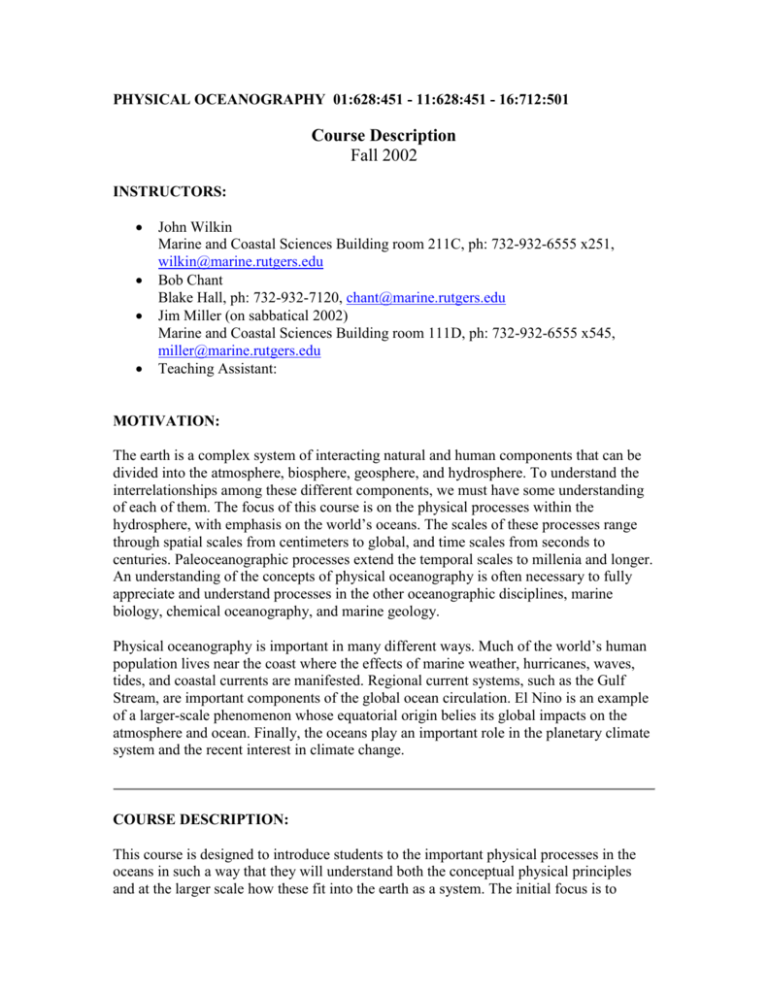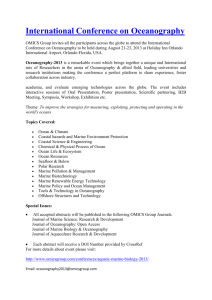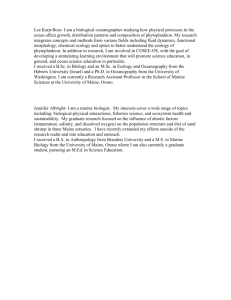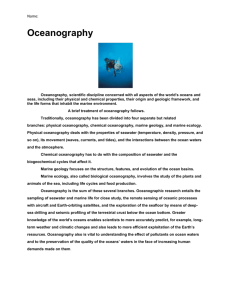physical oceanography 11:628:451 - Institute of Marine and Coastal
advertisement

PHYSICAL OCEANOGRAPHY 01:628:451 - 11:628:451 - 16:712:501 Course Description Fall 2002 INSTRUCTORS: John Wilkin Marine and Coastal Sciences Building room 211C, ph: 732-932-6555 x251, wilkin@marine.rutgers.edu Bob Chant Blake Hall, ph: 732-932-7120, chant@marine.rutgers.edu Jim Miller (on sabbatical 2002) Marine and Coastal Sciences Building room 111D, ph: 732-932-6555 x545, miller@marine.rutgers.edu Teaching Assistant: MOTIVATION: The earth is a complex system of interacting natural and human components that can be divided into the atmosphere, biosphere, geosphere, and hydrosphere. To understand the interrelationships among these different components, we must have some understanding of each of them. The focus of this course is on the physical processes within the hydrosphere, with emphasis on the world’s oceans. The scales of these processes range through spatial scales from centimeters to global, and time scales from seconds to centuries. Paleoceanographic processes extend the temporal scales to millenia and longer. An understanding of the concepts of physical oceanography is often necessary to fully appreciate and understand processes in the other oceanographic disciplines, marine biology, chemical oceanography, and marine geology. Physical oceanography is important in many different ways. Much of the world’s human population lives near the coast where the effects of marine weather, hurricanes, waves, tides, and coastal currents are manifested. Regional current systems, such as the Gulf Stream, are important components of the global ocean circulation. El Nino is an example of a larger-scale phenomenon whose equatorial origin belies its global impacts on the atmosphere and ocean. Finally, the oceans play an important role in the planetary climate system and the recent interest in climate change. COURSE DESCRIPTION: This course is designed to introduce students to the important physical processes in the oceans in such a way that they will understand both the conceptual physical principles and at the larger scale how these fit into the earth as a system. The initial focus is to develop the basic equations that describe the principles upon which physical oceanography is based. These principles are then used to help understand waves, tides, currents, and the large-scale ocean circulation. Homework problems are assigned to reinforce the concepts learned in class. Throughout the course, examples will be given to show how physical oceanography affects and is affected by biological, chemical, and geological processes in the ocean. OBJECTIVES: To introduce students to the basic principles underlying the physical processes in the ocean. To show students that the basic physical principles can be represented with mathematical equations. To apply the basic physical principles to develop an understanding of specific ocean phenomena and processes. To understand some of the important linkages between physical oceanography and the other oceanographic disciplines-- marine biology, chemical oceanography, and marine geology. To help understand why physical oceanography is important in the earth system and to learn about the interactions with other components of the system, particularly the atmosphere. GRADING: Three exams (75%) Homework (25%) RECOMMENDED TEXTS: Introductory Dynamical Oceanography, S. Pond and G. Pickard Ocean Circulation, The Open University, J. Brown et al. OTHER REFERENCES ON RESERVE: Principles of Ocean Physics, J. Apel The Physical Oceanography of Coastal Waters, K. F. Bowden Waves, Tides and Shallow Water Processes, The Open University, J. Brown et al. Data Analysis Methods in Physical Oceanography, W. Emery and R.E. Thomson Introduction to Physical Oceanography, Second Edition, John Knauss, 1997 Introduction to Physical Oceanography, G. Mellor Descriptive Physical Oceanography, G. Pickard and W. Emery Regional Oceanography: An Introduction, M. Tomczak and J. Godfrey







